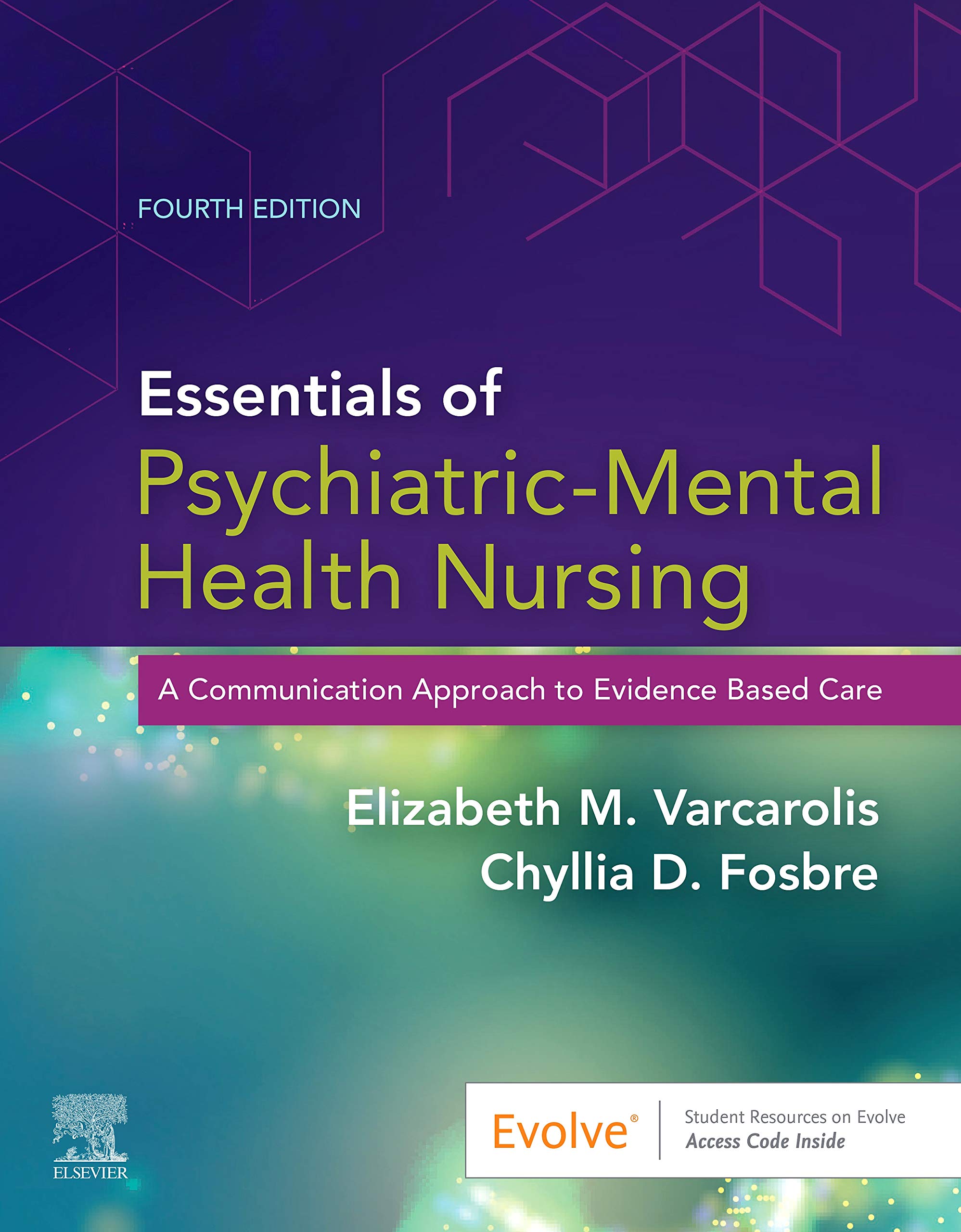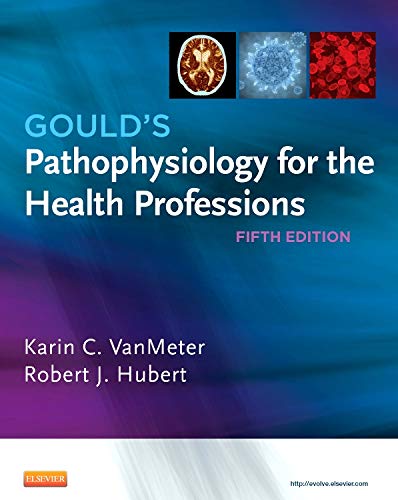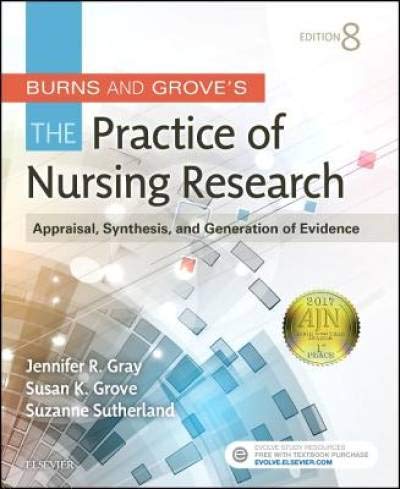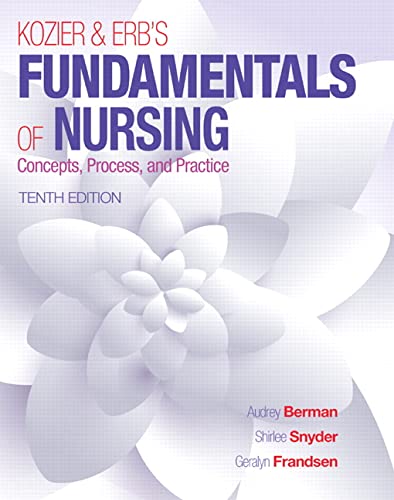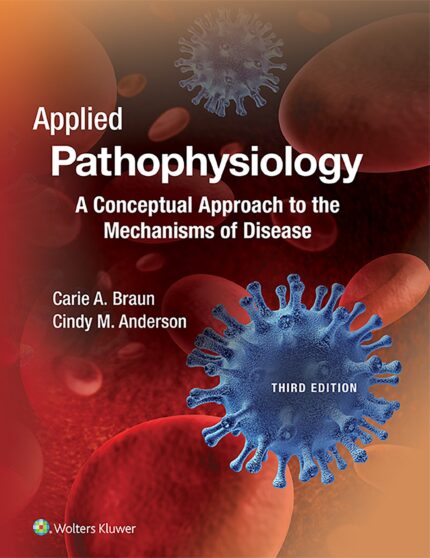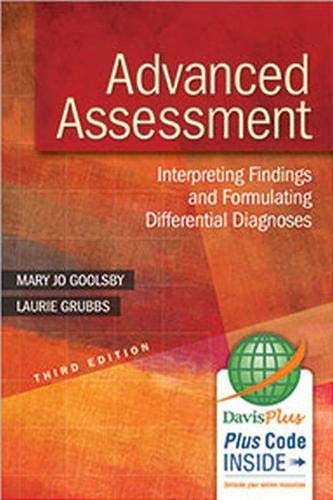Test Bank For Essentials of Psychiatric Mental Health Nursing 4th Edition Varcarolis Nursing
Test Bank For Essentials of Psychiatric Mental Health Nursing 4th Edition by Varcarolis Nursing
Essentials of Psychiatric Mental Health Nursing 4th Edition by Varcarolis Nursing – Test Bank
Test Bank For Essentials of Psychiatric Mental Health Nursing 4th Edition by Varcarolis Nursing
Test Bank For Essentials of Psychiatric Mental Health Nursing
Chapter 01: Science and the Therapeutic Use of Self in Psychiatric Mental Health
Nursing
Varcarolis: Essentials of Psychiatric Mental Health Nursing: A Communication
Approach to Evidence-Based Care, 4th Edition
MULTIPLE CHOICE
1. Which outcome, focused on recovery, would be expected in the plan of care for a patient
living in the community and diagnosed with serious and persistent mental illness? Within 3
months, the patient will demonstrate what behavior?
a. Denying suicidal ideation
b. Reporting a sense of well-being
c. Taking medications as prescribed
d. Attending clinic appointments on time
ANS: B
Recovery emphasizes managing symptoms, reducing psychosocial disability, and improving
role performance. The goal of recovery is to empower the individual with mental illness to
achieve a sense of meaning and satisfaction in life and to function at the highest possible level
of wellness. The incorrect options focus on the classic medical model rather than recovery.
DIF: Cognitive Level: Application (Applying)
TOP: Nursing Process: Outcomes Identification
MSC: NCLEX: Health Promotion and Maintenance
2. A patient is hospitalized for depression and suicidal ideation after their spouse asks for a
divorce. Select the nurse’s most caring comment.
a. “Let’s discuss healthy means of coping when you have suicidal feelings.”
b. “I understand why you’re so depressed. When I got divorced, I was devastated
too.”
c. “You should forget about your marriage and move on with your life.”
d. “How did you get so depressed that hospitalization was necessary?”
ANS: A
The nurse’s communication should evidence caring and a commitment to work with the
patient. This commitment lets the patient know the nurse will help. Probing and advice are not
helpful for therapeutic interventions.
DIF: Cognitive Level: Application (Applying)
TOP: Nursing Process: Implementation MSC: NCLEX: Psychosocial Integrity
3. In the shift-change report, an off-going nurse criticizes a patient who wears extremely heavy
makeup. Which comment by the nurse who receives the report best demonstrates advocacy?
a. “This is a psychiatric hospital, so we expect our patients to behave bizarrely.”
b. “Let’s all show acceptance of this patient by wearing lots of makeup too.”
c. “Your comments are inconsiderate and inappropriate. Keep the report objective.”
d. “Our patients need our help to learn behaviors that will help them get along in
society.”
ANS: D
Accepting patients’ needs for self-expression and seeking to teach skills that will contribute to
their well-being demonstrate respect and are important parts of advocacy. The on-coming
nurse needs to take action to ensure that others are not prejudiced against the patient. Humor
can be appropriate within the privacy of a shift report but not at the expense of respect for
patients. Judging the off-going nurse in a critical way will create conflict. Nurses must show
compassion for each other.
DIF: Cognitive Level: Application (Applying)
TOP: Nursing Process: Implementation MSC: NCLEX: Safe, Effective Care Environment
4. A nurse assesses a newly admitted patient diagnosed with major depressive disorder. Which
statement is an example of “attending”?
a. “We all have stress in life. Being in a psychiatric hospital is not the end of the
world.”
b. “Tell me why you felt you had to be hospitalized to receive treatment for your
depression.”
c. “You will feel better after we get some antidepressant medication started for you.”
d. “I’d like to sit with you for a while, so you may feel more comfortable talking with
me.”
ANS: D
Attending is a technique that demonstrates the nurse’s commitment to the relationship and
reduces feelings of isolation. This technique shows respect for the patient and demonstrates
caring. Generalizations, probing, and false reassurances are nontherapeutic.
DIF: Cognitive Level: Application (Applying)
TOP: Nursing Process: Implementation MSC: NCLEX: Psychosocial Integrity
5. A patient shows the nurse an article from the Internet about a health problem. Which
characteristic of the website’s address most alerts the nurse that the site may have biased and
prejudiced information?
a. Address ends in “.org.”
b. Address ends in “.com.”
c. Address ends in “.gov.”
d. Address ends in “.net.”
ANS: B
Financial influences on a site are a clue that the information may be biased. “.com” at the end
of the address indicates that the site is a commercial one. “.gov” indicates that the site is
maintained by a government entity. “.org” indicates that the site is nonproprietary; the site
may or may not have reliable information, but it does not profit from its activities. “.net” can
have multiple meanings.
DIF: Cognitive Level: Comprehension (Understanding) TOP: Nursing Process: Evaluation
MSC: NCLEX: Health Promotion and Maintenance
6. A nurse says, “When I was in school, I learned to call upset patients by name to get their
attention; however, I read a descriptive research study that says that this approach does not
work. I plan to stop calling patients by name.” Which statement is the best appraisal of this
nurse’s comment?
a. One descriptive research study rarely provides enough evidence to change practice.
b. Staff nurses apply new research findings only with the help from clinical nurse
specialists.
c. New research findings should be incorporated into clinical algorithms before using
them in practice.
d. The nurse misinterpreted the results of the study. Classic tenets of practice do not
change.
ANS: A
Descriptive research findings provide evidence for practice but must be viewed in relation to
other studies before practice changes. One study is not enough. Descriptive studies are low on
the hierarchy of evidence. Clinical algorithms use flowcharts to manage problems and do not
specify one response to a clinical problem. Classic tenets of practice should change as
research findings provide evidence for change.
DIF: Cognitive Level: Analysis (Analyzing) TOP: Nursing Process: Evaluation
MSC: NCLEX: Health Promotion and Maintenance
7. Two nursing students discuss career plans after graduation. One student wants to enter
psychiatric nursing. The other student asks, “Why would you want to be a psychiatric nurse?
All they do is talk. You will lose your skills.” Select the best response by the student
interested in psychiatric nursing.
a. “Psychiatric nurses’ practice in safer environments than other specialties and
nurse-to-patient ratios are better because of the nature of patients’ problems.”
b. “Psychiatric nurses use complex communication skills, as well as critical thinking,
to solve multidimensional problems. I’m challenged by those situations.”
c. “I think I will be good in the mental health field. I do not like clinical rotations in
school, so I do not want to continue them after I graduate.”
d. “Psychiatric nurses do not have to deal with as much pain and suffering as
medical-surgical nurses. That appeals to me.”
ANS: B
The practice of psychiatric nursing requires a different set of skills than medical-surgical
nursing, although substantial overlap does exist. Psychiatric nurses must be able to help
patients with medical and mental health problems, reflecting the holistic perspective these
nurses must have. Nurse–patient ratios and workloads in psychiatric settings have increased,
similar to other specialties. Psychiatric nursing involves clinical practice, not simply
documentation. Psychosocial pain is real and can cause as much suffering as physical pain.
DIF: Cognitive Level: Application (Applying)
TOP: Nursing Process: Implementation MSC: NCLEX: Safe, Effective Care Environment
8. Which research evidence would most influence a group of nurses to change their practice?
a. Expert committee report of recommendations for practice
b. Systematic review of randomized controlled trials
c. Nonexperimental descriptive study
d. Critical pathway
ANS: B

